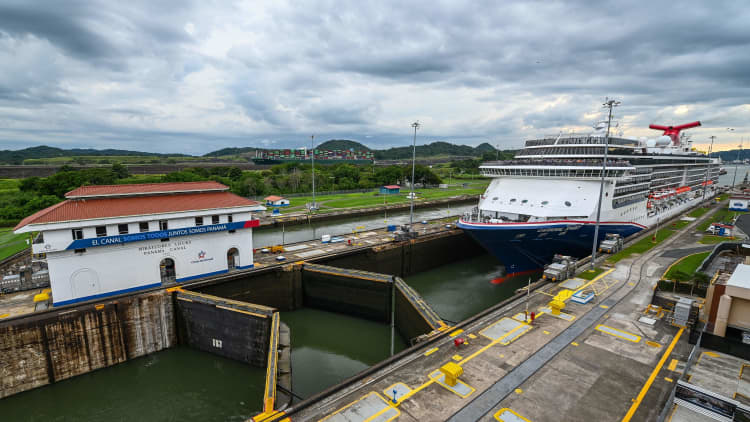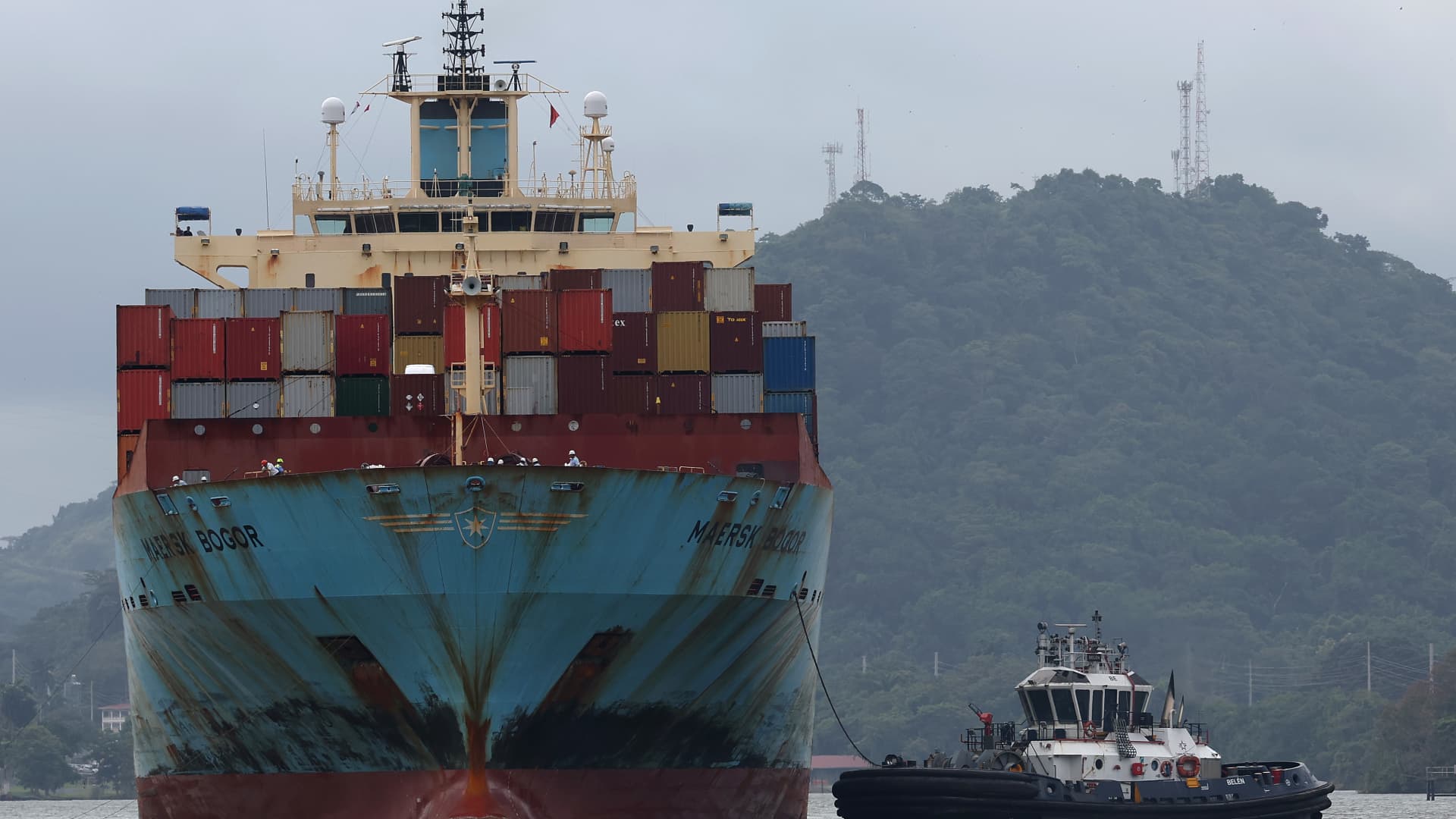The container ship Maersk Bogor is guided by a tugboat as it prepares to enter the Miraflores locks while transiting the Panama Canal on September 22, 2023 in Panama City, Panama. The Panama Canal Authority is continuing to restrict the number of vessels that pass through the Panama Canal locks as drought has caused water levels at Gatun Lake to drop.
Justin Sullivan | Getty Images News | Getty Images
Starting Friday, the Panama Canal Authority is implementing additional vessel reductions in an effort to conserve water as a drought exacerbated by a severe El Nino weather system continues to plague water levels in the locks of the key global trade conduit.
According to Panama Canal authorities, the drought requires them to reduce the number of daily transits from 29 to 25 ships and in the proceeding weeks, they will reduce vessels transits even more until it declines to 18 ships a day in February. That represents between 40%-50% of full capacity. Under normal conditions, between 34-36 vessels traversed the canal daily. The drought and vessel reductions are having a major impact on the flow of trade, according to data from CNBC Supply Chain providers.
According to Project44, shipping containers going through the Panama Canal to the U.S. East Coast are being delayed in select ports, with the Port of Charleston seeing the longest in delays.
The Panama Canal is popular for East Coast trade because it is faster than other options. The shipping time for ocean cargo from Shenzhen, China, to Miami, Florida, using the Suez Canal takes 41 days. Traveling through the Panama Canal takes only 35 days.
“With a reduced transit schedule and an average of 26 daily arrivals by commercial ships per day on the Pacific side of the canal, and an average of 8 daily arrivals by commercial ships per day on the Atlantic side of the canal, the likelihood of cargo waiting idle will increase,” said Captain Adil Ashiq, head of North America for MarineTraffic.
According to MarineTraffic, wait times have increased on the Atlantic side from last week on average by 30% (0.4 days to 0.6 days) and on the Pacific side, wait times have increased to 2.2 days.
The delays are leading shippers sending cargo to U.S. East Coast and West Coast ports to make alternativee plans, says Alan Baer, CEO of OL USA.
“The extra money and time traveling through the Suez may add a week to ten days for cargo to arrive, but you know when it will reach its final destination,” Baer said.
Jon Davis, chief meteorologist at global supply chain mapping and risk analytics company Everstream Analytics, tells CNBC that since a significant portion of global commerce is transported through the Canal, the items that are impacted cover all sectors.
“Coal is transported through the canal but the more important energy item is LNG (liquefied natural gas) which the U.S. exports around the world, especially to Asia,” said Davis. “Many agricultural products are shipped both from, and to, the U.S. The canal is a major corridor for container ships, so products coming to the U.S., from China for example, are being delayed.”
Containerships have priority in crossing the canal due to their contracts. The most impacted vessel types are wet bulk and dry bulk vessels, Ashiq said.
“This may start a shift in bookings for Transpacific freight destined to the U.S. East and Gulf through the Suez Canal, which is located in a region with significant geopolitical headwinds,” said Paul Brashier, vice president of drayage and intermodal at ITS Logistics.
The Panama Canal issues come amid a challenging market for shippers in economic terms, with a “massive freight recession” leading to business shutdowns, global shipping bellwether Maersk announcing 10,000 layoffs on Friday amid weak results, and an uncertain outlook for demand.

In a recent speech before the Houston International Maritime Conference, Panama Canal Authority Administrator Ricaurte Vásquez Morales said, “This will be the worst El Nino recorded in recent history.”
In its water conservation battle, Dr. Vásquez emphasized the authority anticipates it can “provide and assure for as long as possible,” the current water levels so vessels do not have to further lighten their loads. At present conditions, vessels are traversing the canal 40% lighter. To meet the weight requirements, some containerships are unloading their containers and moving them either by rail or road across Panama to be loaded on vessels on the other side. Vásquez said the canal will attempt to keep current vessel weight requirements even if it requires further reductions in the number of transits.
According to the PCA, it takes around 50 million gallons of fresh water to move a vessel through one of the locks. The Panamax locks lose more water compared to the Neo-Panamax lock. The Neo-Panamax locks have a water recovery system which can reclaim 60% of the water used during a vessel’s transit through the locks. The Panamax lanes do not have the water-recapturing ability of the Neo-Panamax locks.
Forty percent of all U.S. container traffic travels through the Panama Canal every year, which in all, moves roughly $270 billion in cargo annually.

